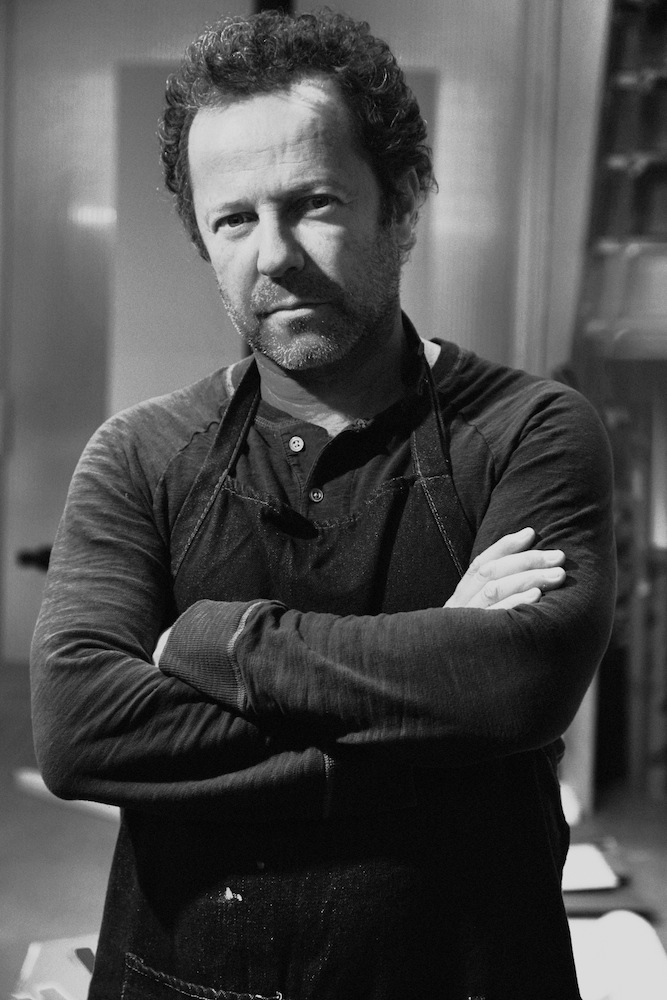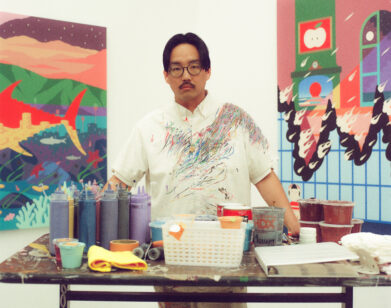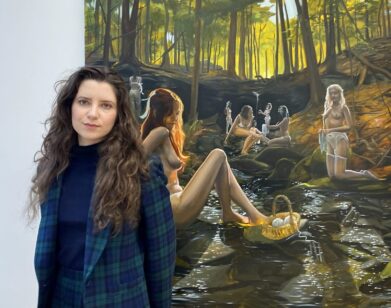Vik Muniz’s Illusory Reality
VIK MUNIZ IN NEW YORK, MAY 2016. PORTRAIT: JASON RODGERS.
Vik Muniz doesn’t want to fool you. In fact, he wants to bring you closer to reality. His latest exhibition, “Handmade,” which opened last week at Galeria Nara Roesler in São Paulo, Brazil, urges spectators to meditate on the importance of illusion and perception, concepts around which Muniz has based the majority of his artwork thus far.
The Brazilian artist, who is known best for drawing using unorthodox but mundane materials (think Leonardo Da Vinci’s The Last Supper made with chocolate syrup) has, over the past thirty years, produced pieces that are astounding, oftentimes amusing—playful, even—but not without depth. At face value, many of Muniz’s works may seem intended to merely astonish: he’s drawn clouds thousands of feet above Manhattan using exhaust from a crop duster, created enormous Robert Smithson-esque drawings using a backhoe and earth as a canvas, and recreated art historical classics using garbage (Jean-François Millet’s The Sower made with debris, for instance)—the latter of which he filmed for a documentary titled Waste Land, which went on to receive an award from Sundance Film Festival and a nomination from the Academy in 2010.
Muniz’s ambitious creations extend far beyond pleasing gimmicks and tricks in the sky; they’re informed by art history, physics, studies of light, the science of optics, and philosophy—topics in which Muniz is well versed. The 54-year-old’s body of work, and in particular “Handmade,” examines the line between representation and reality by bending the line between object and image.
We caught up with Muniz over the phone before the opening of his exhibition to discuss “Handmade,” the necessity of illusions, and his fascination with light.
PIMPLOY PHONGSIRIVECH: I know “Handmade” is a bit of a departure from your more well-known works where you recreate iconic images using sugar, garbage, marinara sauce, and whatnot. What can we expect from this one?
VIK MUNIZ: Well, it’s a late departure, you know. Last year I did a second edition of a catalogue raisonné, and when you organize your work [and] look back at your entire production. It may feel like you’re looking at a straight line, but in fact it’s nothing like that. The work is very experimental and most of the time it develops like branches. I usually see a capillary, like a tree shape where there are … branches that sort of move because you’re not tending to them. In this case, I had the opportunity to analyze that dead end.
I found myself doing something I hadn’t done before; I fixed a photograph [of charcoal] with a piece of charcoal. I realized that I never interfered with a surface photograph before. It took me back to the late ’80s when I was starting to work with photography but I did not have the same kind of respect or regard for the surface of the image. It took me to one of my first photographs, Two Nails. It’s in a collection at the Museum of Modern Art in New York and it’s a picture of a nail hung by a real nail. I think that’s very emblematic of the entire exhibition: trying to create tension between something material and something pictorial.
PHONGSIRIVECH: Right. An illusion.
MUNIZ: Yeah, this is everywhere in the show. I didn’t feel comfortable about working with abstraction; I was intimidated by the tradition of abstract. I have an academic training as an artist, I used to draw nudes and things like that, and modern art was very intimidating to me. I think that right now I’m beyond that and I could pick up where I left with Two Nails, and I imagined an entire career—as if that would be the main tree.
The whole exhibition is about perception and what you see and what you fail to see because of what you think you know about the image. I really bared it down to the mechanics of how an image operates—the core grammar of the image. It’s also a very interesting way to understand how your eye falls for the simplest illusions.
PHONGSIRIVECH: You once said, “Illusion is a key prerequisite in any type of language.” Could you elaborate?
MUNIZ: I think that the development of any culture has something to do with the way people deal with the concept of illusion. The fact that the sound of my voice and the way I modulate it creates pictures in your head … in order for us to accumulate knowledge, we have to create symbolic exchanges that let ourselves be fooled temporarily by something that’s not there—by a substitute for reality. When you talk about representation, you’re talking about language.
When you deal with illusion at this level, you’re not just creating pictures—you know, I don’t want to fool people. If I wanted to do that, I would be working with virtual reality. I want to operate on the other level, the other end of the illusion spectrum. I want to create the worst possible illusions so it doesn’t really fool people, but [instead] give people a measure of their own belief. It makes them aware of how much they need to be fooled in order to understand the world around them.
PHONGSIRIVECH: You’ve always had this fascination with perception and reality. Where did it all begin?
MUNIZ: Well, when I was 14 I won an art contest for public schools in São Paulo. As a prize I was awarded a year—and then my father paid for the other year—of academic drawing. When you’re 14 and you spend your entire afternoon drawing naked people… [laughs] I was very into it and I think it paid off because I started drawing better and better. I started thinking a lot about perspective, and what makes people see something in a picture. How do you understand perception in a picture? It was something that was fascinating to me. After that I became largely self-taught, but the idea of perception and of how it basically makes the world around us directly into pictures—that always captivated me. I wanted to be a psychologist at the beginning, but I wasn’t a very good student. I started working with advertising for a while.
My work in advertising was with billboards. When you’re dealing with billboards you’re dealing with an image that changes as you approach it. It has a lot to do with the speed of approach, the angle. … You start to become really, really aware of the dynamic of how a picture changes. That picture is not something inert or static—any image on a wall is a cinematic event because you walk towards it and you make it change and it transforms itself before you as you approach. I’ve been delving into all kinds of theories about vision all the way from the 11th century. I’m crazy about optics. It’s interesting that a lot of these things that we know or that we study or develop about optics were very close to religion.
Only in the 20th century, artists started taking the study of perception in a more humane way. They were thinking about the eye as being an instrument, the whole body as being a visual instrument. That sort of gave way a little bit with Cartesian—the “Cogito [ergo sum]” argument. It’s not, “I think therefore I exist.” It’s, “I feel therefore I think therefore I exist.” It has to do with phenomenology and many other thinking currents that came in the 20th century. I’m a product of that. I am what [Marshall] McLuhan described—I’m a student of media and I’ve always been one. I’m fascinated by the way we make the world around us based on pictures and how can we improve our perception of this picture world.
PHONGSIRIVECH: So I read an interview you did almost a decade ago—
MUNIZ: Oh! [laughs]
PHONGSIRIVECH: You said some really striking things about light, and how you have almost this infatuation with pure light.
MUNIZ: I think pure light has something to do with actually seeing everything at once. It’s kind of a nirvana of sorts. The analogy that I made was that the same way we cannot understand god we cannot understand pure light. We need things to intermediate. We need an interface to understand everything at once. In the case of churches, I remember looking at the glass…
PHONGSIRIVECH: Stained glass?
MUNIZ: Yes, stained glass. Seeing images of saints … it just struck me that we need saints; we need this head—this talking head—to communicate. Every single religion you have people that go in-between, that can talk to god or communicate ideas. … Then there are the talking heads in the news every time we watch TV. No matter how complex, you still need a person there to tell you what happened: a storyteller of sorts. I find that fascinating that we feel so attached to this primitive mode of connection, this primitive interface to the world. You know what, I think that [in] the end it’s a very simple question, a very poignant question, of what is art?
PHONGSIRIVECH: And what would you say?
MUNIZ: I think art is the development of this interface between mind and matter, between mind and phenomenon, between what’s inside of us and what’s happening outside of us. It developed over the course of the last 35,000 years. We made a lot of improvements because it not only gave us the tools to understand the world better, but it also gave us better and better tools to do it. It’s that continuous relationship: technology and discernment.
PHONGSIRIVECH: So with all these complex, sort of philosophical ideas that inform your entire process and ultimately your creations, how accessible do you think your work and its message is?
MUNIZ: I think I’m an ambitious artist but you have to understand the measure of your influence on people. You’re not going to change people’s lives with your art. What you do is you give them a little pat so that you change the course of the direction that they’re going. Give it a little bump. Every time you show something to somebody they’re going in one direction, when they see that thing you did they’re going to go off track—maybe towards a direction that you think is more important. They’ll be more discerning, they’ll probably see things a little bit more profoundly, they’ll spend more time trying to understand what’s in front of them.
I think there’s a gradient that goes from science to art and magic is the middle ground. I think that we’re all trying to understand and define the world around us but often it’s experimental. I’m not creating art that starts with politics or starts with ethics. I feel I am a conceptual artist because my art is more concerned with epistemology than ethics or politics or even aesthetics.
PHONGSIRIVECH: I still remember Waste Land very distinctly. Do you have any other documentaries in the works or anything in the same vein?
MUNIZ: Waste Land was something that was really interesting because it appeared at a time when I was working and thinking of doing that body of work and I just documented it. For the last 15 years I’ve been making total realistic copies—they’re objects—facsimiles of the back of the most famous paintings in the world. I did Starry Night, La Gioconda [Mona Lisa]. … I just finished Anatomy Lesson [of Dr. Nicolaes Tulp], The Girl With The Pearl Earring. Now I’m going to Vienna this month to do The Kiss by [Gustav] Klimt. You can put the original right next to my copy and you could not tell the difference. This series is called “Verso,” and I’ve been tempted to do a documentary with the same name because when I started doing this I realized that in the back of every painting there’s an entire universe that makes it possible for the painting to be there: an army of conservators, technicians, people who maintain these things, the market. I want to do a piece or a documentary about what happens behind a painting; it’s just a plan but it’s got enough potential to be a documentary very soon.
“HANDMADE” WILL BE ON VIEW AT GALERIA NARA ROESLER IN SÃO PAULO, BRAZIL THROUGH NOVEMBER 5, 2016. FORE MORE ON VIK MUNIZ, VISIT HIS WEBSITE.







